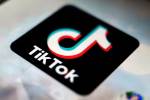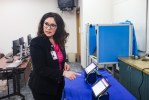Printed books still king in academia
Jessie Papperman is hitting the books old-school.
Scattered across her table at the University of Nevada, Las Vegas Student Center are her sticky note-annotated textbook, a clutch of handouts, scattered class notes and other materials she uses to study for her Japanese language class.
What doesn’t appear amid this arsenal of study aids: An e-textbook. That’s because Papperman, a senior — the Japanese course she took this summer was the last class she needed for her English degree — finds that learning comes most effectively to her via printed, rather than digitized, study materials.
Papperman is no stranger to reading e-books. She allows that e-books, with their built-in search capability, could be useful in some lower-level English courses. But she says, for something as intellectually rigorous as learning a foreign language, “printed books are necessary.”
Papperman isn’t alone in her preference for traditional bound textbooks. And while most returning college students this fall probably will use at least some form of digitized content in their studies, when they have a choice, most, like Papperman, opt for printed textbooks over e-textbooks.
Charles Schmidt, director of public relations for the National Association of College Stores, which represents more than 3,000 college bookstores and retailers across the country, says a study conducted by the organization found that 77 percent of students “if they had their choice, would prefer the print textbook.”
The reason? Mostly because “that’s what they are most comfortable with,” Schmidt says.
“Yes, these students in college today are facile with technology. But when they started their study habits, back when they were in middle school and junior high and high school, print books were still pretty much king.”
That doesn’t mean those students don’t use digitized study materials. For example, many printed textbooks come with codes that students use to access online study guides, assignments, animations, workbooks, videos, graphics and supplemental materials.
Ryan Livengood, district director of College of Southern Nevada Bookstores, says e-textbooks started appearing as an option for college students about six years ago. Although sales were relatively slow at first, “I would say that over the past two years we’ve seen a dramatic increase in our digital sales,” he says.
About 1 out of 5 students opt for at least one digital offering per semester, Livengood says, while the selection of digital textbooks has “doubled as more publishers make (them) available.”
Comparatively speaking, digital textbook sales are still a small percentage of total textbook sales, Livengood says. “But as more publishing companies move more to the digital rather than the print age, we’ll see more and more.”
One thing that may hasten the migration is the cost of textbooks. According to the National Association of College Stores, students estimate that they spend $662 annually on required course materials. For some students, the possibility of saving a few dollars may be enough to at least consider an e-textbook.
Livengood says CSN bookstores’ goal is to offer students as many buying options as possible. Among those options: buying a new printed textbook, buying a used printed textbook or renting a printed textbook, or, on the digital side, purchasing or renting a digital textbook (Livengood says e-textbooks typically are rentals).
Consider, for example, one textbook required for a communications course at CSN. Students may buy a new copy of the printed book for $172, buy a used copy of the printed book for $129 or rent a printed copy of the book for $86. If students opt to go digital, they can rent a digital version of the book for 180 days for $92, which is less expensive than buying either a new or used print version of it, but still $6 more than renting a print copy of it.
In other cases, however, a student can realize significant savings by going digital. For example, Livengood says, a collection of about a half-dozen textbooks used in CSN’s nursing program will cost $750 in printed form, but about $400 as a collection of e-books.
As students become more accustomed to studying with digital materials and as publishers release more titles in e-book form, “I think we’ll be seeing more students choosing that digital book.” Livengood says.
Papperman can’t imagine herself as one of them. She says the ability to easily mark and annotate pages of her printed textbook, the ability of a printed book to be viewed easily alongside other study materials and the way in which information is presented in a printed textbook will continue to make printed textbooks her study tool of choice.
Alan Robles, a sophomore UNLV fine arts/graphic design major, agrees. “I just think I prefer the textbooks,” he says.
E-books may be “more convenient,” he adds, “but I guess it’s a habit you just get used to.”
Robles says that studying requires a different type of reading than, say, reading a novel, and “I feel like, with a (printed) book, you actually read it more than just skipping through it.”
Amanda Thompson, a senior accounting student, prefers printed books for both academic and recreational reading. For one thing, she tends to flip back to other pages while reading a textbook, and with an e-book, “I can’t flip back as easily.”
Actually, Thompson says, “I’ve never been a big e-reader fan. I’ve always just liked the paper books.”
Schmidt suspects that as publishers find ways to better take advantage of the interactive potential digital books offer, students’ willingness to embrace digitized textbooks will grow.
Right now, most e-textbooks are “glorified PDFs of the print version,” he says. “I’ve seem some demonstrations of them, and it is kind of clunky moving around in them.”
But students “are very used to online interactive experiences,” Schmidt says. “So if you’re reading a chapter about astronomy and the creation of a black hole, they want to be able to click on something that takes them to a live shot from the Hubble space telescope of a black hole or an interactive game.”
“Once they develop that,” Schmidt says, students will “see the value in that.”
Eventually, digital textbooks might even be able to offer students a more vivid educational experience.
Imagine, says Ed Nagelhout, an associate professor of rhetoric and writing in UNLV’s English department, that a professor could create his or her own e-book that combines the text of a printed textbook with material written by the professor, public domain materials — books, videos, graphics — and links to online resources right within the book’s text, all in a single, downloadable and relatively inexpensive package.
“To me, it seems like students are used to the hard copy book,” Nagelhout says. But he suspects students also “would like something new, as long as it gives them a better experience.”
In addition, future generations of college students may well embrace digital textbooks in a way today’s print-reared students may not. Nagelhout suspects that the printed textbook won’t disappear, “but I think it will be generational.”
“Children as young as preschool are already becoming more acclimated to these kinds of tools, so they’ll have expectations for how they’ll get their information — how they’ll get their material — that are fundamentally different,” he says.
Contact reporter John Przybys at jprzybys@review journal.com or 702-383-0280.


























